Removal of Fluoroquinolone Antibiotics by Chitosan–Magnetite from Aqueous: Single and Binary Adsorption
Abstract
:1. Introduction
2. Materials and Methods
2.1. Chemicals
2.2. Synthesis Adsorbate Materials
2.3. Characterization
2.4. Adsorption Experiments
2.4.1. Single Adsorption
2.4.2. Binary Adsorption
2.5. Regeneration Study
3. Results
3.1. Characterization of Material
3.2. Single Adsorption of CFX and LFX Antibiotic
3.2.1. Determination of Adsorption Ability
3.2.2. Effect of pH
3.2.3. Effect of Initial Concentration and Contact Time
3.2.4. Effect of Adsorbent Dose
3.2.5. Adsorption Kinetic Models
3.2.6. Adsorption Isotherm Models
3.3. Binary Adsorption
3.3.1. Effect of Mutual Interference in Binary Solutions
3.3.2. The Langmuir Competitive Model
3.4. Possible Mechanism of Adsorption
3.5. Reusability of CS-MNPs
3.6. Application to Actual Samples
4. Conclusions
Author Contributions
Funding
Data Availability Statement
Conflicts of Interest
References
- Du, B.; Yang, Q.; Wang, R.; Wang, R.; Wang, Q.; Xin, Y. Evolution of Antibiotic Resistance and the Relationship between the Antibiotic Resistance Genes and Microbial Compositions under Long-Term Exposure to Tetracycline and Sulfamethoxazole. Int. J. Environ. Res. Public Health 2019, 16, 4681. [Google Scholar] [CrossRef] [Green Version]
- Friedman, N.D.; Temkin, E.; Carmeli, Y. The negative impact of antibiotic resistance. Clin. Microbiol. Infect. 2016, 22, 416–422. [Google Scholar] [CrossRef]
- Kraemer, S.A.; Ramachandran, A.; Perron, G.G. Antibiotic Pollution in the Environment: From Microbial Ecology to Public Policy. Microorganisms 2019, 7, 180. [Google Scholar] [CrossRef] [Green Version]
- Carvalho, I.T.; Santos, L. Antibiotics in the aquatic environments: A review of the European scenario. Environ. Int. 2016, 94, 736–757. [Google Scholar] [CrossRef] [PubMed]
- Fekadu, S.; Alemayehu, E.; Dewil, R.; Van der Bruggen, B. Pharmaceuticals in freshwater aquatic environments: A comparison of the African and European challenge. Sci. Total Environ. 2019, 654, 324–337. [Google Scholar] [CrossRef] [PubMed]
- Li, Z.; Li, M.; Zhang, Z.; Li, P.; Zang, Y.; Liu, X. Antibiotics in aquatic environments of China: A review and meta-analysis. Ecotoxicol. Environ. Saf. 2020, 199, 110668. [Google Scholar] [CrossRef] [PubMed]
- Binh, V.N.; Dang, N.; Anh, N.T.K.; Ky, L.X.; Thai, P.K. Antibiotics in the aquatic environment of Vietnam: Sources, concentrations, risk and control strategy. Chemosphere 2018, 197, 438–450. [Google Scholar] [CrossRef] [PubMed] [Green Version]
- Liu, X.; Lu, S.; Guo, W.; Xi, B.; Wang, W. Antibiotics in the aquatic environments: A review of lakes, China. Sci. Total Environ. 2018, 627, 1195–1208. [Google Scholar] [CrossRef]
- Szymańska, U.; Wiergowski, M.; Sołtyszewski, I.; Kuzemko, J.; Wiergowska, G.; Woźniak, M.K. Presence of antibiotics in the aquatic environment in Europe and their analytical monitoring: Recent trends and perspectives. Microchem. J. 2019, 147, 729–740. [Google Scholar] [CrossRef]
- Baylan, N. Adsorption of cipro fl oxacin hydrochloride on multiwall carbon nanotube. J. Mol. Struct. 2020, 1206, 127711. [Google Scholar] [CrossRef]
- Chen, H.; Gao, B.; Li, H. Removal of sulfamethoxazole and ciprofloxacin from aqueous solutions by graphene oxide. J. Hazard. Mater. 2015, 282, 201–207. [Google Scholar] [CrossRef]
- Akhtar, J.; Amin, N.A.S.; Shahzad, K. A review on removal of pharmaceuticals from water by adsorption. Desalin. Water Treat. 2016, 57, 12842–12860. [Google Scholar] [CrossRef]
- Yu, K.F.; Li, P.; Li, H.; Zhang, B.; Yang, J.; Huang, F.-Y.; Li, R.; He, Y. Potential of coagulation to remove particle-associated and free-living antibiotic resistome from wastewater. J. Hazard. Mater. 2021, 406, 124295. [Google Scholar] [CrossRef] [PubMed]
- Liu, Q.; Hou, J.; Wu, J.; Miao, L.; You, G.; Ao, Y. Intimately coupled photocatalysis and biodegradation for effective simultaneous removal of sulfamethoxazole and COD from synthetic domestic wastewater. J. Hazard. Mater. 2022, 423, 127063. [Google Scholar] [CrossRef]
- Taoufik, N.; Boumya, W.; Achak, M.; Sillanpää, M.; Barka, N. Comparative overview of advanced oxidation processes and biological approaches for the removal pharmaceuticals. J. Environ. Manag. 2021, 288, 112404. [Google Scholar] [CrossRef] [PubMed]
- Bayan, E.M.; Pustovaya, L.E.; Volkova, M.G. Recent advances in TiO2-based materials for photocatalytic degradation of antibiotics in aqueous systems. Environ. Technol. Innov. 2021, 24, 101822. [Google Scholar] [CrossRef]
- Mao, Q.; Zhou, Y.; Yang, Y.; Zhang, J.; Liang, L.; Wang, H.; Luo, S.; Luo, L.; Jeyakumar, P.; Ok, Y.S.; et al. Experimental and theoretical aspects of biochar-supported nanoscale zero-valent iron activating H2O2 for ciprofloxacin removal from aqueous solution. J. Hazard. Mater. 2019, 380, 120848. [Google Scholar] [CrossRef]
- Du, L.; Xu, W.; Liu, Y.; Li, X.; Huang, D.; Wu, S. Removal of Sulfamethoxazole in Aqueous Solutions by Iron-Based Advanced Oxidation Processes: Performances and Mechanisms. Water Air Soil Pollut. 2020, 231, 159. [Google Scholar] [CrossRef]
- Al-Jabari, M.H.; Sulaiman, S.; Ali, S.; Barakat, R.; Mubarak, A.; Khan, S.A. Adsorption study of levofloxacin on reusable magnetic nanoparticles: Kinetics and antibacterial activity. J. Mol. Liq. 2019, 291, 111249. [Google Scholar] [CrossRef]
- Kyzas, G.Z.; Fu, J.; Lazaridis, N.K.; Bikiaris, D.N.; Matis, K.A. New approaches on the removal of pharmaceuticals from wastewaters with adsorbent materials. J. Mol. Liq. 2015, 209, 87–93. [Google Scholar] [CrossRef]
- Xiang, Y.; Xu, Z.; Zhou, Y.; Wei, Y.; Long, X.; He, Y.; Zhi, D.; Yang, J.; Luo, L. A sustainable ferromanganese biochar adsorbent for effective levofloxacin removal from aqueous medium. Chemosphere 2019, 237, 124464. [Google Scholar] [CrossRef]
- Bakshi, P.S.; Selvakumar, D.; Kadirvelu, K.; Kumar, N.S. Chitosan as an environment friendly biomaterial—A review on recent modifications and applications. Int. J. Biol. Macromol. 2020, 150, 1072–1083. [Google Scholar] [CrossRef]
- Rampino, A.; Borgogna, M.; Blasi, P.; Bellich, B.; Cesàro, A. Chitosan nanoparticles: Preparation, size evolution and stability. Int. J. Pharm. 2013, 455, 219–228. [Google Scholar] [CrossRef]
- Saheed, I.O.; Da Oh, W.; Suah, F.B.M. Chitosan modifications for adsorption of pollutants—A review. J. Hazard. Mater. 2021, 408, 124889. [Google Scholar] [CrossRef] [PubMed]
- Wan Ngah, W.S.; Teong, L.C.; Hanafiah, M. Adsorption of dyes and heavy metal ions by chitosan composites: A review. Carbohydr. Polym. 2011, 83, 1446–1456. [Google Scholar] [CrossRef]
- Lyn, F.H.; Peng, T.C.; Ruzniza, M.Z.; Hanani, Z.N. Nur Hanani, Effect of oxidation degrees of graphene oxide (GO) on the structure and physical properties of chitosan/GO composite films. Food Packag. Shelf Life 2019, 21, 100373. [Google Scholar] [CrossRef]
- Razzaz, A.; Ghorban, S.; Hosayni, L.; Irani, M.; Aliabadi, M. Chitosan nanofibers functionalized by TiO2 nanoparticles for the removal of heavy metal ions. J. Taiwan Inst. Chem. Eng. 2016, 58, 333–343. [Google Scholar] [CrossRef]
- Kadam, A.; Jang, J.; Lim, S.-R.; Lee, D.S. Low-Cost Magnetic Fe3O4/Chitosan Nanocomposites for Adsorptive Removal of Carcinogenic Diazo Dye. Theor. Found. Chem. Eng. 2020, 54, 655–663. [Google Scholar] [CrossRef]
- Le, T.N.; Tran, T.D.; Kim, M.I. A Convenient Colorimetric Bacteria Detection Method Utilizing Chitosan-Coated Magnetic Nanoparticles. Nanomaterials 2020, 10, 92. [Google Scholar] [CrossRef] [Green Version]
- Malakootian, M.; Nasiri, A.; Asadipour, A.; Faraji, M.; Kargar, E. A facile and green method for synthesis of ZnFe2O4@CMC as a new magnetic nanophotocatalyst for ciprofloxacin removal from aqueous media. MethodsX 2019, 6, 1575–1580. [Google Scholar] [CrossRef]
- Wang, Y.; Yan, T.; Gao, L.; Cui, L.; Hu, L.; Yan, L.; Du, B.; Wei, Q. Magnetic hydroxypropyl chitosan functionalized graphene oxide as adsorbent for the removal of lead ions from aqueous solution. Desalin. Water Treat. 2016, 57, 3975–3984. [Google Scholar] [CrossRef]
- Chang, Y.-C.; Chen, D.-H. Preparation and adsorption properties of monodisperse chitosan-bound Fe3O4 magnetic nanoparticles for removal of Cu(II) ions. J. Colloid Interface Sci. 2005, 283, 446–451. [Google Scholar] [CrossRef]
- Erwin, A.; Salomo, S.; Adhy, P.; Utari, N.; Ayu, W.; Wita, Y.; Nani, S. Magnetic iron oxide particles (Fe3O4) fabricated by ball milling for improving the environmental quality. IOP Conf. Ser. Mater. Sci. Eng. 2020, 845, 12051. [Google Scholar] [CrossRef]
- Huang, H.Y.; Shieh, Y.T.; Shih, C.M.; Twu, Y.K. Magnetic chitosan/iron (II, III) oxide nanoparticles prepared by spray-drying. Carbohydr. Polym. 2010, 81, 906–910. [Google Scholar] [CrossRef]
- Panda, S.K.; Aggarwal, I.; Kumar, H.; Prasad, L.; Kumar, A.; Sharma, A.; Vo, D.-V.N.; Van Thuan, D.; Mishra, V. Magnetite nanoparticles as sorbents for dye removal: A review. Environ. Chem. Lett. 2021, 19, 2487–2525. [Google Scholar] [CrossRef]
- Zulfikar, M.A.; Afrita, S.; Wahyuningrum, D.; Ledyastuti, M. Preparation of Fe3O4-chitosan hybrid nano-particles used for humic acid adsorption. Environ. Nanotechnol. Monit. Manag. 2016, 6, 64–75. [Google Scholar] [CrossRef]
- Ashiq, A.; Vithanage, M.; Sarkar, B.; Kumar, M.; Bhatnagar, A.; Khan, E.; Xi, Y.; Ok, Y.S. Carbon-based adsorbents for fluoroquinolone removal from water and wastewater: A critical review. Environ. Res. 2021, 197, 111091. [Google Scholar] [CrossRef] [PubMed]
- Mohammad, R.E.A.; Elbashir, A.A.; Karim, J.; Yahaya, N.; Rahim, N.Y.; Miskam, M. Adsorptive performances of magnetic graphene oxide adsorbent for the removal of fluoroquinolones in the Langat River Basin, Malaysia. Int. J. Environ. Anal. Chem. 2021, 1–20. [Google Scholar] [CrossRef]
- Pretali, L.; Fasani, E.; Sturini, M. Current advances on the photocatalytic degradation of fluoroquinolones: Photoreaction mechanism and environmental application. Photochem. Photobiol. Sci. 2022, 21, 899–912. [Google Scholar] [CrossRef]
- Karimi-Maleh, H.; Ayati, A.; Davoodi, R.; Tanhaei, B.; Karimi, F.; Malekmohammadi, S.; Orooji, Y.; Fu, L.; Sillanpää, M. Recent advances in using of chitosan-based adsorbents for removal of pharmaceutical contaminants: A review. J. Clean. Prod. 2021, 291, 125880. [Google Scholar] [CrossRef]
- Gao, B.; Chang, Q.; Cai, J.; Xi, Z.; Li, A.; Yang, H. Removal of fluoroquinolone antibiotics using actinia-shaped lignin-based adsorbents: Role of the length and distribution of branched-chains. J. Hazard. Mater. 2020, 403, 123603. [Google Scholar] [CrossRef]
- Gao, B.; Chang, Q.; Yang, H. Selective adsorption of ofloxacin and ciprofloxacin from a binary system using lignin-based adsorbents: Quantitative analysis, adsorption mechanisms, and structure-activity relationship. Sci. Total Environ. 2021, 765, 144427. [Google Scholar] [CrossRef]
- Bui, Q.M.; Nguyen, V.D.; Vu, T.Q.; Nguyen, L.T.N.; Nguyen, H.T.H. Removal of anionic dye from aqueous solution by chitosan—Magnetite nanocomposite. Int. J. Environ. Anal. Chem. 2022, 1–21. [Google Scholar] [CrossRef]
- Sureshkumar, V.; Daniel, S.C.G.K.; Ruckmani, K.; Sivakumar, M. Fabrication of chitosan–magnetite nanocomposite strip for chromium removal. Appl. Nanosci. 2016, 6, 277–285. [Google Scholar] [CrossRef] [Green Version]
- Soares, P.I.; Machado, D.; Laia, C.; Pereira, L.C.; Coutinho, J.T.; Ferreira, I.M.; Novo, C.M.; Borges, J.P. Thermal and magnetic properties of chitosan-iron oxide nanoparticles. Carbohydr. Polym. 2016, 149, 382–390. [Google Scholar] [CrossRef]
- Tomke, P.D.; Rathod, V.K. Facile fabrication of silver on magnetic nanocomposite (Fe3O4@Chitosan–AgNP nanocomposite) for catalytic reduction of anthropogenic pollutant and agricultural pathogens. Int. J. Biol. Macromol. 2020, 149, 989–999. [Google Scholar] [CrossRef]
- Li, G.-Y.; Jiang, Y.-R.; Huang, K.-L.; Ding, P.; Chen, J. Preparation and properties of magnetic Fe3O4–chitosan nanoparticles. J. Alloys Compd. 2008, 466, 451–456. [Google Scholar] [CrossRef]
- Rasoulzadeh, H.; Dehghani, M.H.; Mohammadi, A.S.; Karri, R.R.; Nabizadeh, R.; Nazmara, S.; Kim, K.-H.; Sahu, J. Parametric modelling of Pb(II) adsorption onto chitosan-coated Fe3O4 particles through RSM and DE hybrid evolutionary optimization framework. J. Mol. Liq. 2020, 297, 111893. [Google Scholar] [CrossRef]
- Zheng, C.; Zheng, H.; Hu, C.; Wang, Y.; Wang, Y.; Zhao, C.; Ding, W.; Sun, Q. Structural design of magnetic biosorbents for the removal of ciprofloxacin from water. Bioresour. Technol. 2020, 296, 122288. [Google Scholar] [CrossRef]
- Igberase, E.; Osifo, P.; Ofomaja, A. The adsorption of copper (II) ions by polyaniline graft chitosan beads from aqueous solution: Equilibrium, kinetic and desorption studies. J. Environ. Chem. Eng. 2014, 2, 362–369. [Google Scholar] [CrossRef]
- Tewari, P.H.; McLean, A.W. Temperature dependence of point of zero charge of alumina and magnetite. J. Colloid Interface Sci. 1972, 40, 267–272. [Google Scholar] [CrossRef]
- Nasiri, A.; Tamaddon, F.; Mosslemin, M.H.; Gharaghani, M.A.; Asadipour, A. New magnetic nanobiocomposite CoFe2O4@methylcellulose: Facile synthesis, characterization, and photocatalytic degradation of metronidazole. J. Mater. Sci. Mater. Electron. 2019, 30, 8595–8610. [Google Scholar] [CrossRef]
- Yao, B.; Luo, Z.; Du, S.; Yang, J.; Zhi, D.; Zhou, Y. Sustainable biochar/MgFe2O4 adsorbent for levofloxacin removal: Adsorption performances and mechanisms. Bioresour. Technol. 2021, 340, 125698. [Google Scholar] [CrossRef] [PubMed]
- Li, Z.; Hong, H.; Liao, L.; Ackley, C.J.; Schulz, L.A.; Macdonald, R.A.; Mihelich, A.L.; Emard, S.M. A mechanistic study of ciprofloxacin removal by kaolinite. Colloids Surf. B Biointerfaces 2011, 88, 339–344. [Google Scholar] [CrossRef]
- Li, J.; Yu, G.; Pan, L.; Li, C.; You, F.; Xie, S.; Wang, Y.; Ma, J.; Shang, X. Study of ciprofloxacin removal by biochar obtained from used tea leaves. J. Environ. Sci. 2018, 73, 20–30. [Google Scholar] [CrossRef]
- de Luna, M.D.G.; Flores, E.D.; Genuino, D.A.D.; Futalan, C.M.; Wan, M.-W. Adsorption of Eriochrome Black T (EBT) dye using activated carbon prepared from waste rice hulls—Optimization, isotherm and kinetic studies. J. Taiwan Inst. Chem. Eng. 2013, 44, 646–653. [Google Scholar] [CrossRef]
- Movasaghi, Z.; Yan, B.; Niu, C. Adsorption of ciprofloxacin from water by pretreated oat hulls: Equilibrium, kinetic, and thermodynamic studies. Ind. Crops Prod. 2018, 127, 237–250. [Google Scholar] [CrossRef]
- Tao, J.; Yang, J.; Ma, C.; Li, J.; Du, K.; Wei, Z.; Chen, C.; Wang, Z.; Zhao, C.; Deng, X. Cellulose nanocrystals/graphene oxide composite for the adsorption and removal of levofloxacin hydrochloride antibiotic from aqueous solution: Nanocomposites adsorb antibiotics. R. Soc. Open Sci. 2020, 7, 200857. [Google Scholar] [CrossRef]
- Malik, R.; Goyal, A.; Yadav, S.; Gupta, N.; Goel, N.; Kaushik, A.; Kumar, V.; Tikoo, K.B.; Singhal, S. Functionalized magnetic nanomaterials for rapid and effective adsorptive removal of fluoroquinolones: Comprehensive experimental cum computational investigations. J. Hazard. Mater. 2019, 364, 621–634. [Google Scholar] [CrossRef] [PubMed]
- Darweesh, T.M.; Ahmed, M.J. Batch and fixed bed adsorption of levofloxacin on granular activated carbon from date (Phoenix dactylifera L.) stones by KOH chemical activation. Environ. Toxicol. Pharmacol. 2017, 50, 159–166. [Google Scholar] [CrossRef]
- Yi, S.; Gao, B.; Sun, Y.; Wu, J.; Shi, X.; Wu, B.; Hu, X. Removal of levofloxacin from aqueous solution using rice-husk and wood-chip biochars. Chemosphere 2016, 150, 694–701. [Google Scholar] [CrossRef] [PubMed]
- Dhiman, N.; Sharma, N. Removal of pharmaceutical drugs from binary mixtures by use of ZnO nanoparticles: (Competitive adsorption of drugs). Environ. Technol. Innov. 2019, 15, 100392. [Google Scholar] [CrossRef]
- Farajfaed, S.; Sharifian, S.; Asasian-Kolur, N.; Sillanpää, M. Granular silica pillared clay for levofloxacin and gemifloxacin adsorption from aqueous systems. J. Environ. Chem. Eng. 2021, 9, 106306. [Google Scholar] [CrossRef]
- Maity, J.; Ray, S.K. Chitosan based nano composite adsorbent—Synthesis, characterization and application for adsorption of binary mixtures of Pb(II) and Cd(II) from water. Carbohydr. Polym. 2018, 182, 159–171. [Google Scholar] [CrossRef]
- Ni, B.J.; Huang, Q.S.; Wang, C.; Ni, T.Y.; Sun, J.; Wei, W. Competitive adsorption of heavy metals in aqueous solution onto biochar derived from anaerobically digested sludge. Chemosphere 2019, 219, 351–357. [Google Scholar] [CrossRef]
- Abali, M.; Ichou, A.A.; Benhiti, R. Adsorption of Anionic Dyes Using Monoionic and Binary Systems: A Comparative Study. Lett. Appl. NanoBioScience 2021, 10, 2588–2593. [Google Scholar] [CrossRef]
- Nharingo, T.; Ngwenya, T.J. Single and binary sorption of lead(II) and zinc(II) ions onto Eichhornia Crassipes (water hyacinth) ash. Int. J. Eng. Sci. Innov. Technol. 2013, 2, 419–426. [Google Scholar]
- Singh, S.K.; Das, A. The n → π* interaction: A rapidly emerging non-covalent interaction. Phys. Chem. Chem. Phys. 2015, 17, 9596–9612. [Google Scholar] [CrossRef] [PubMed] [Green Version]
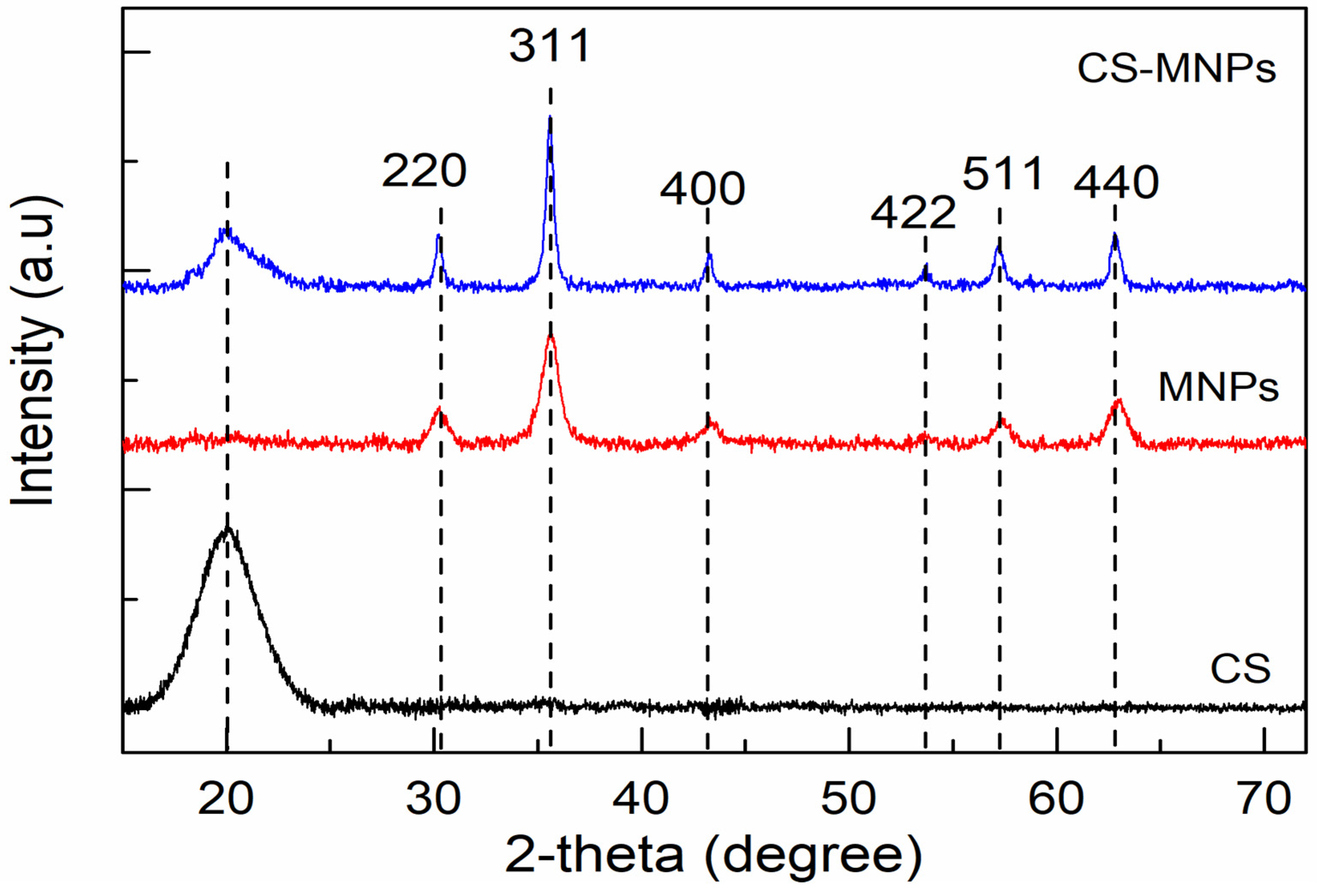
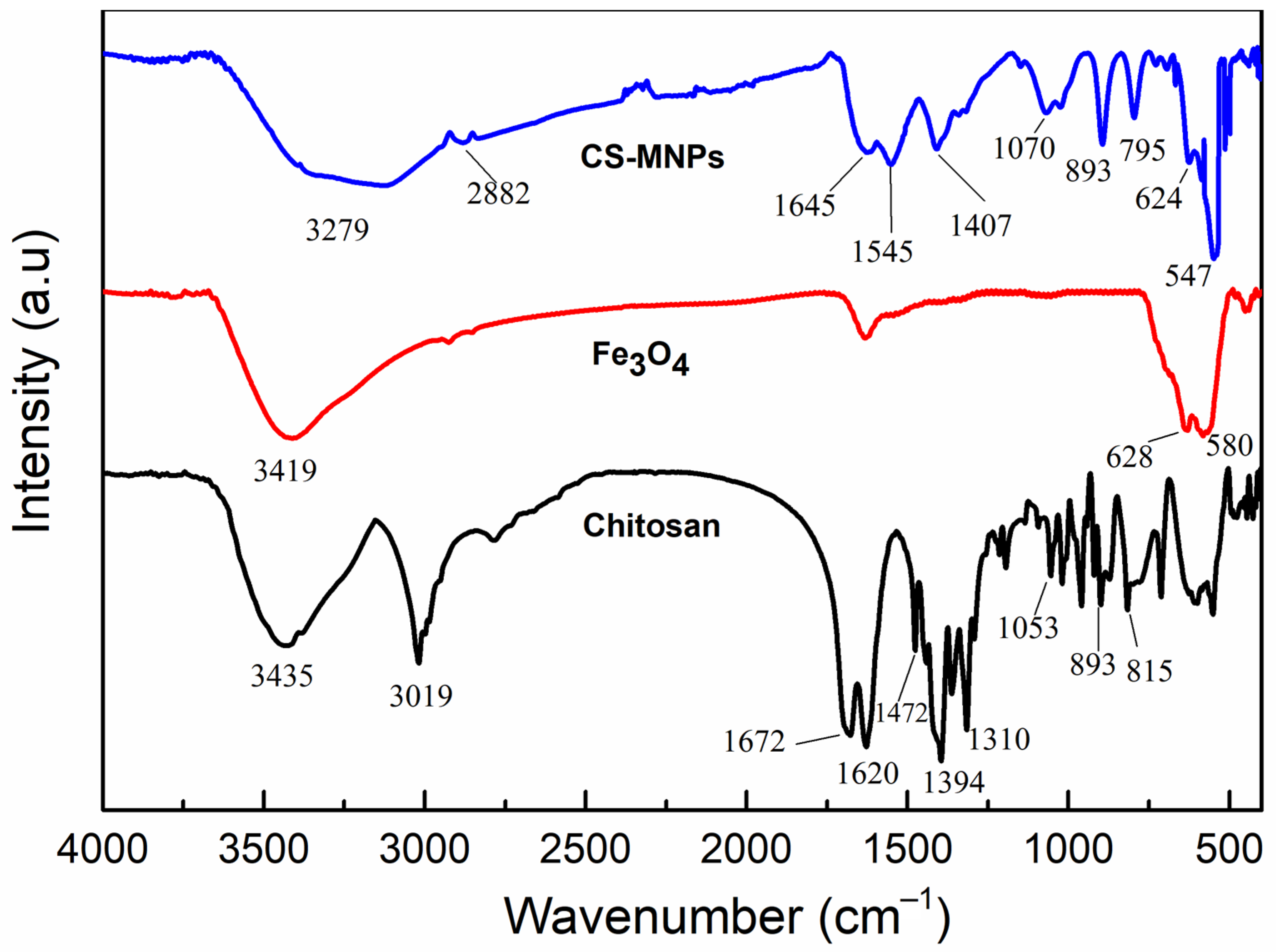




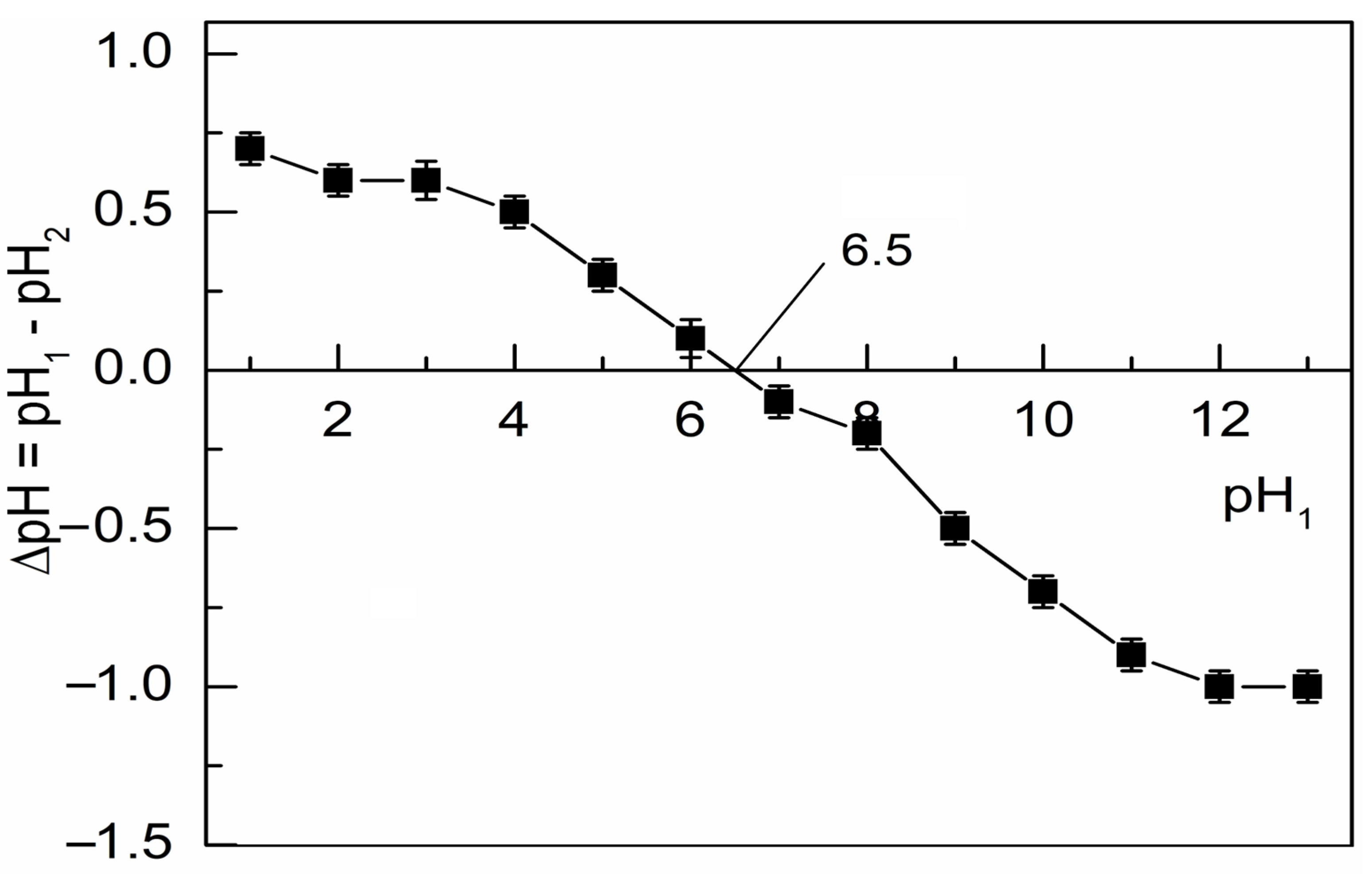
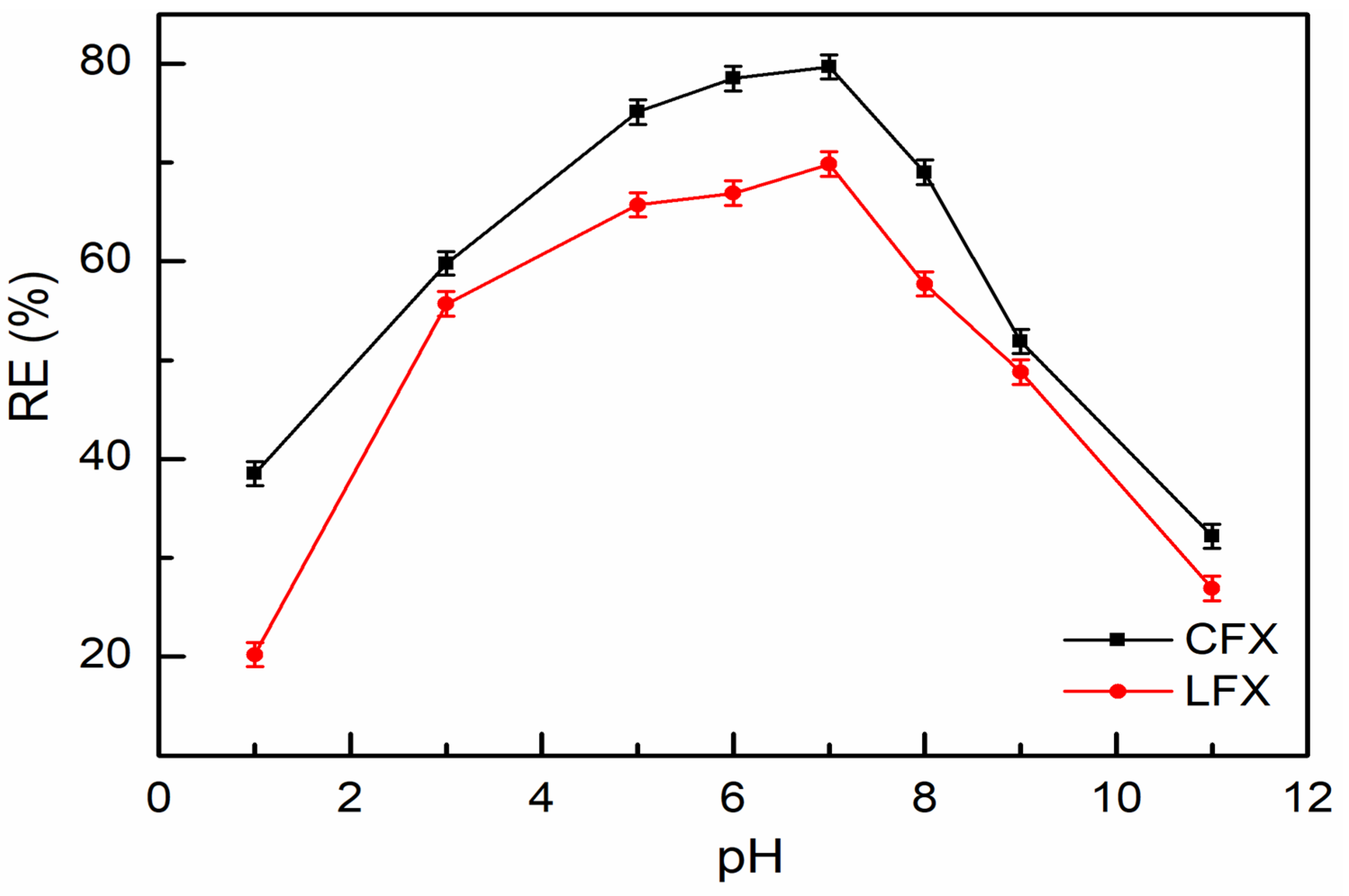
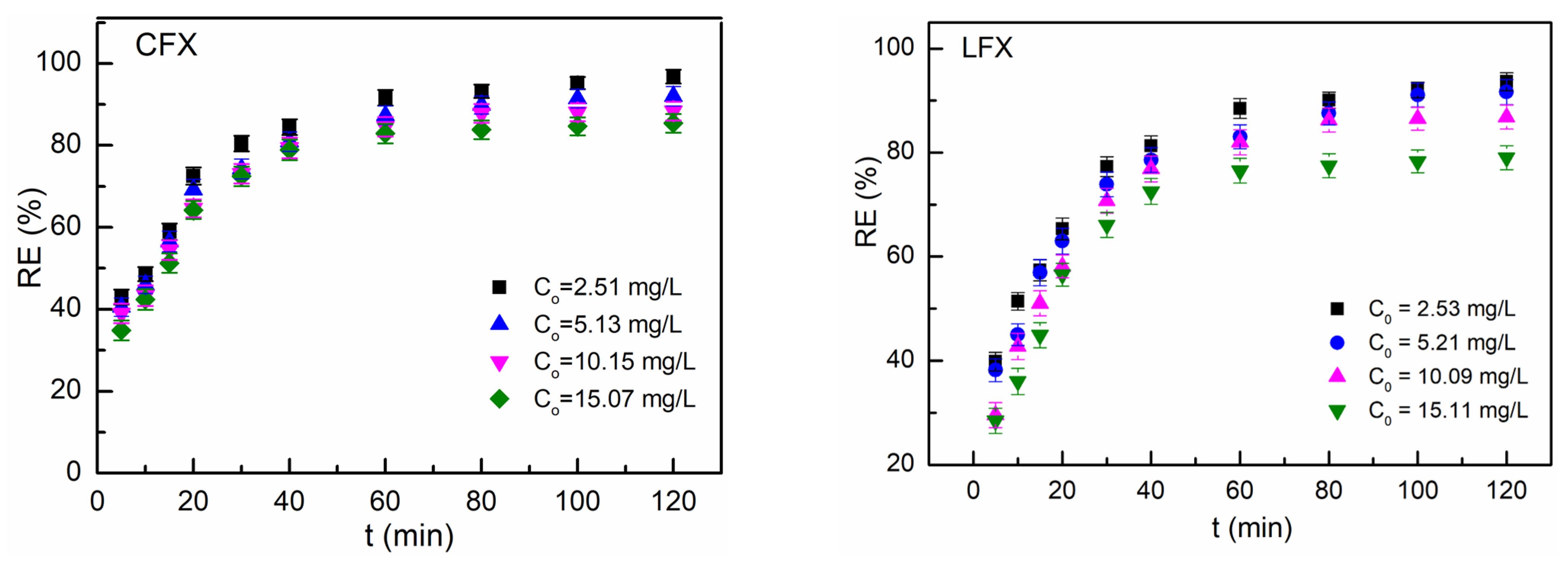
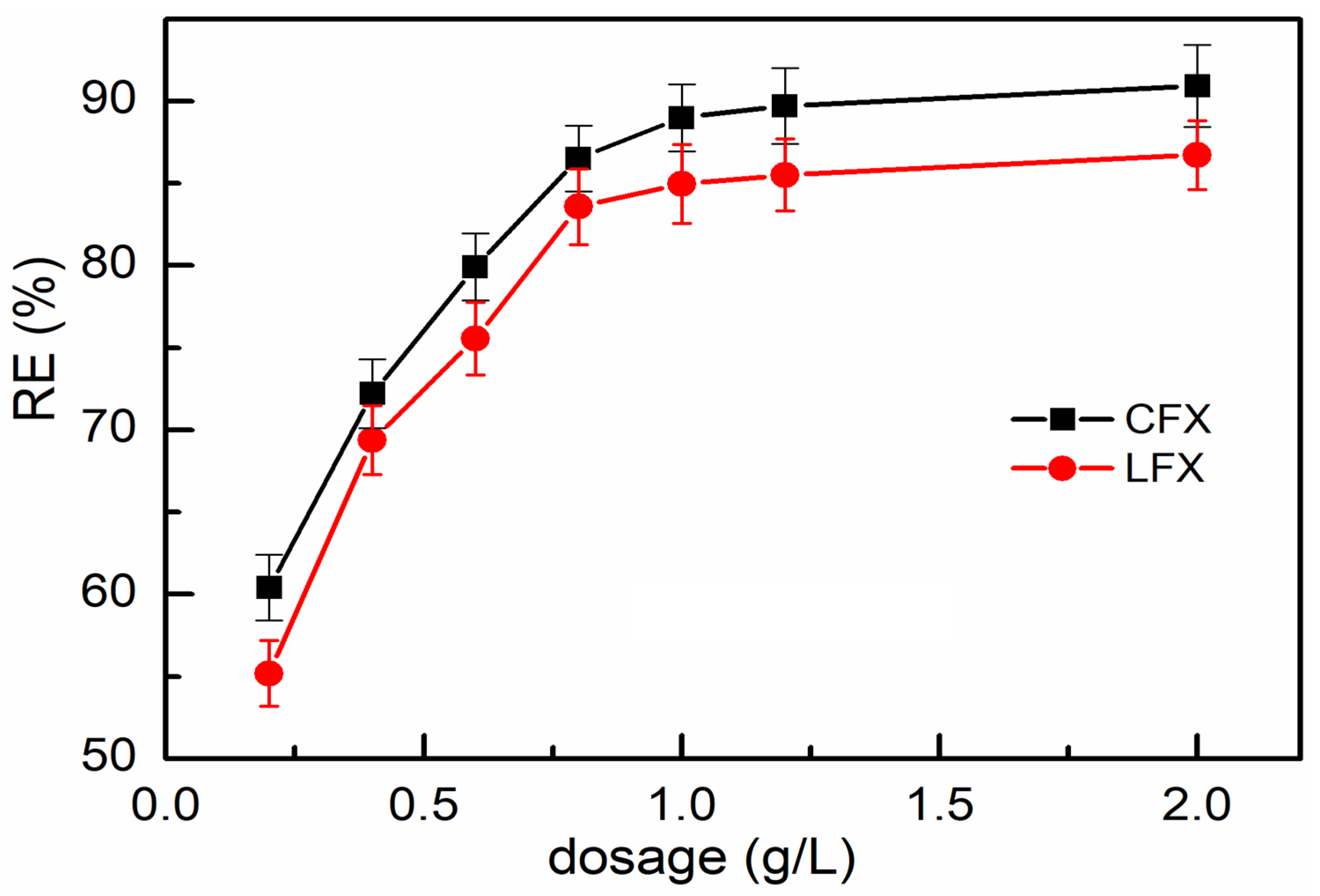

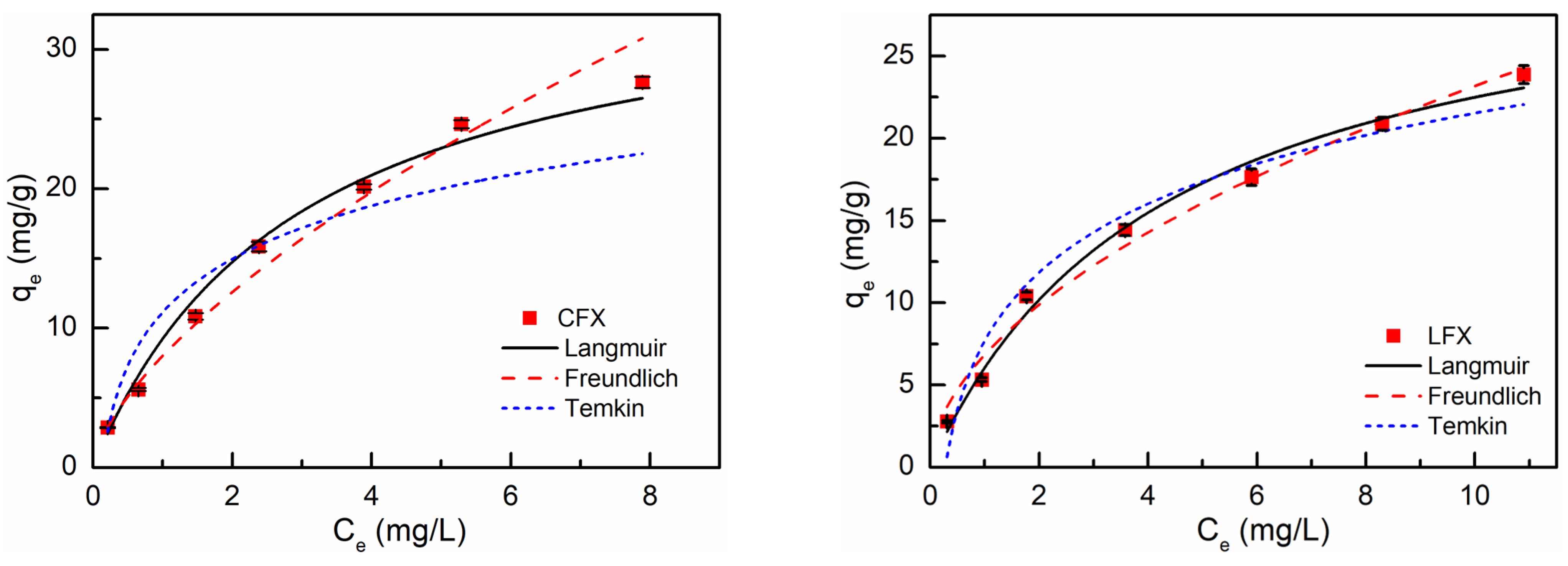
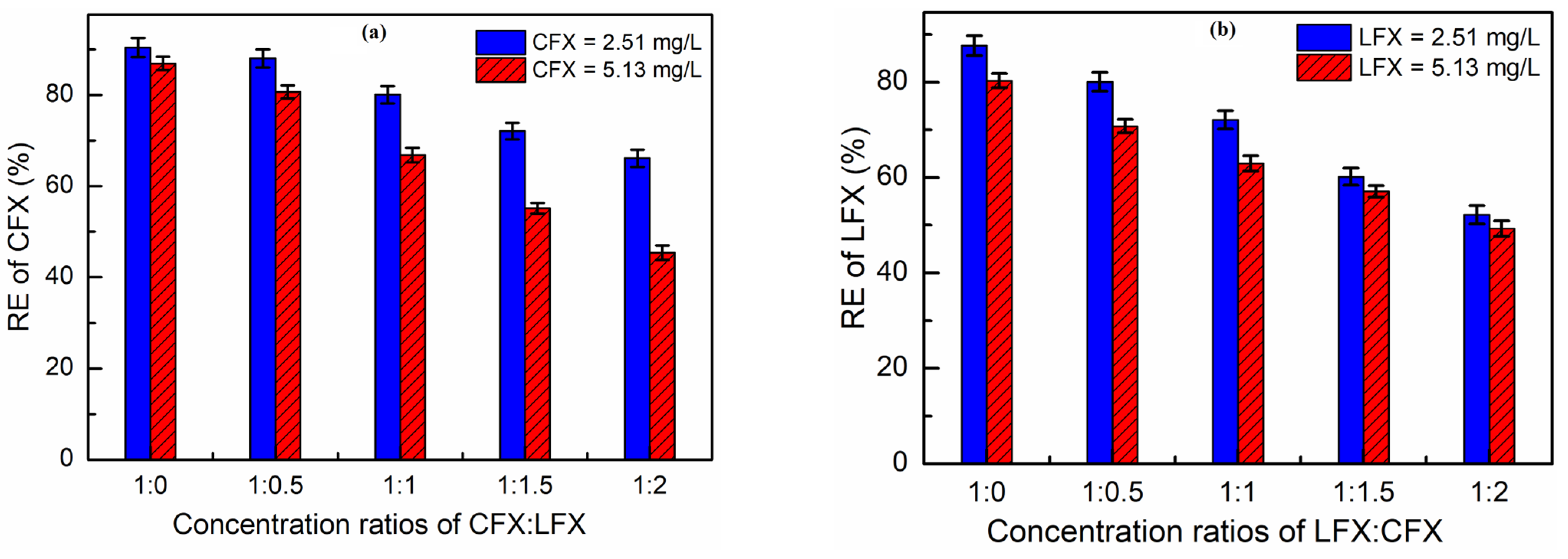
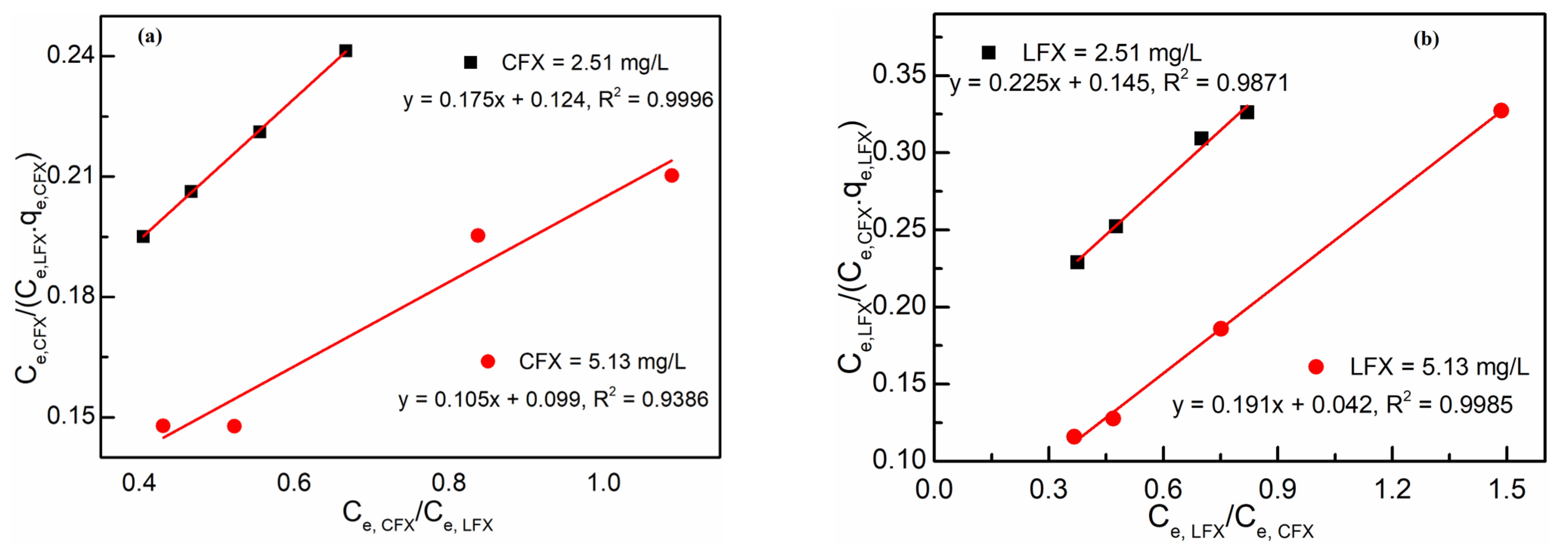


| Experiment/Parameters | pH | Time (min) | CS-MNPs Mass (mg) | Initial Concentration (mg/L) |
|---|---|---|---|---|
| Effect of pH | 1–11 | 30 | 20 | 10.15 |
| Effect of time/initial concentration | 7 | 5 to 120 | 20 | 2.50 to 15.00 |
| Effect of dosage | 7 | 60 | 5–50 | 10 |
| Parameters | CS | MNPs | CS-MNPs |
|---|---|---|---|
| Surface (m2/g) | 3.75 | 90.33 | 79.60 |
| Average pore size (nm) | 18.39 | 17.75 | 8.43 |
| Pore volume (cm3/g) | 0.02 | 0.42 | 0.17 |
| C0 (mg/L) | Pseudo-First-Order | qe,exp | Pseudo-Second-Order | ||||
|---|---|---|---|---|---|---|---|
| K1 (1/min) | qe (mg/g) | Statistical Analysis | K2 (g/mg·min) | qe (mg/g) | Statistical Analysis | ||
| CFX | |||||||
| 2.51 | 0.08 | 2.82 | R2 = 0.912 MAE = 0.217 MSE = 0.047 RMSE = 0.218 | 3.04 | 0.03 | 3.22 | R2 = 0.963 MAE = 0.180 MSE = 0.033 RMSE = 0.181 |
| 5.13 | 0.08 | 5.50 | R2 = 0.908 MAE = 0.513 MSE = 0.265 RMSE = 0.515 | 6.01 | 0.02 | 6.35 | R2 = 0.964 MAE = 0.337 MSE = 0.114 RMSE = 0.338 |
| 10.15 | 0.07 | 10.66 | R2 = 0.926 MAE = 0.550 MSE = 0.400 RMSE = 0.633 | 11.21 | 0.80 × 10−2 | 12.36 | R2 = 0.966 MAE = 0.147 MSE = 0.024 RMSE = 0.155 |
| 15.07 | 0.07 | 15.79 | R2 = 0.962 MAE = 1.157 MSE = 1.341 RMSE = 1.158 | 16.95 | 0.54 × 10−3 | 17.83 | R2 = 0.970 MAE = 0.880 MSE = 0.780 RMSE = 0.883 |
| LFX | |||||||
| 2.53 | 0.07 | 2.81 | R2 = 0.928 MAE = 0.127 MSE = 0.016 RMSE = 0.128 | 2.94 | 0.03 | 3.05 | R2 = 0.984 MAE = 0.113 MSE = 0.013 RMSE = 0.113 |
| 5.21 | 0.08 | 5.44 | R2 = 0.915 MAE = 0.540 MSE = 0.296 RMSE = 0.544 | 5.98 | 0.02 | 6.15 | R2 = 0.975 MAE = 0.173 MSE = 0.031 RMSE = 0.176 |
| 10.09 | 0.06 | 10.74 | R2 = 0.979 MAE = 0.350 MSE = 0.125 RMSE = 0.354 | 11.01 | 0.64 × 10−2 | 11.19 | R2 = 0.992 MAE = 0.147 MSE = 0.047 RMSE = 0.217 |
| 15.11 | 0.05 | 14.74 | R2 = 0.979 MAE = 1.150 MSE = 1.323 RMSE = 1.150 | 15.89 | 0.14 × 10−2 | 16.97 | R2 = 0.995 MAE = 1.080 MSE = 1.166 RMSE = 1.080 |
| Pollutant | Langmuir Isotherm | |||
| qm (mg/g) | KL (L/g) | RL | R2 | |
| CFX | 36.31 | 0.34 | 0.54–0.09 | 0.991 |
| LFX | 32.22 | 0.23 | 0.63–0.13 | 0.989 |
| Freundlich isotherm | ||||
| NF | KF (mg1−(1/n) L1/n/g) | R2 | ||
| CFX | 1.54 | 8.02 | 0.981 | |
| LFX | 1.89 | 6.84 | 0.984 | |
| Temkin isotherm | ||||
| bT (J/mol) | KT (L/mg) | R2 | ||
| CFX | 450.47 | 7.60 | 0.902 | |
| LFX | 411.60 | 3.58 | 0.954 | |
| No. | Pollutant | Adsorbent | pH | Temp | Time | Adsorption Capacity (mg/g) | Ref. |
|---|---|---|---|---|---|---|---|
| 1 | CFX | MWCNT | Not given | 25 °C | 200 min | 4.95 | [10] |
| 2 | CFX | Kaonilite | 3–4.5 | 25 °C | 20 min | 6.29 | [54] |
| 3 | CFX | GO | 5.0 | NG | 12 h | 379 | [11] |
| 4 | CFX | Dopa-CoF NPs-CIP | 7.0 | 25 °C | 30 min | 16.53 | [59] |
| 5 | CFX | Mela-CoF NPs | 7.0 | 25 °C | 30 min | 14.04 | [59] |
| 6 | LFX | Fe3O4 | 6.5 | 33 °C | 240 min | 6.85 | [19] |
| 7 | LFX | CNCs-GO | 4.0 | 25 °C | 240 min | 49.72 | [58] |
| 8 | LFX | Biochar/ferrite composites | 5.0 | 25 °C | 240 min | 55.50 | [53] |
| 9 | LFX | Date stone AC | 9.0 | 30 °C | 24 h | 100.38 | [60] |
| 10 | LFX | Rice husk biochar | 8.0 | 30 °C | 24 h | 4.99 | [61] |
| 11 | LFX | Wood chip biochar | 6.5 | 30 °C | 24 h | 7.22 | [61] |
| 12 | CFX | CS-MNPS | 6.0 | 20 °C | 60 min | 36.31 | In this study |
| 13 | LFX | 6.0 | 20 °C | 60 min | 32.22 |
| System | C0, CFX (mg/L) | qm, CFX (mg/g) | KL,1 = bLFX/bCFX | R2 |
| CFX:LFX | 2.51 | 5.71 | 0.71 | 0.999 |
| 5.13 | 9.52 | 0.94 | 0.939 | |
| LFX:CFX | C0,LFX (mg/L) | qm, LFX (mg/g) | KL,2 = bCFX/bLFX | R2 |
| 2.51 | 4.44 | 0.64 | 0.987 | |
| 5.13 | 5.24 | 0.22 | 0.998 |
| Samples | Physicochemical Properties | CCFX (mg/L) | RE (%) | CLFX (mg/L) | RE (%) |
|---|---|---|---|---|---|
| S1 | pH 7.4, conductivity: 135 µS/cm, DO: 5 mg/L, Ca 40 mg/L, Mg 8 mg/L, Fe 15 mg/L | 2.05 ± 0.04 | 98.53 ± 2.20 | 1.37 ± 0.02 | 98.21 ± 2.30 |
| S2 | pH 7.7, conductivity: 226 µS/cm, DO: 3 mg/L, Ca 42 mg/L, Mg 10 mg/L, Fe 17 mg/L | 0.51 ± 0.02 | 99.26 ± 2.56 | 0.98 ± 0.03 | 99.45 ± 3.20 |
| S3 | pH 7.6, conductivity: 319 µS/cm, DO: 4 mg/L, Ca 55 mg/L, Mg 12 mg/L, Fe 15 mg/L | 0.94 ± 0.02 | 98.92 ± 2.42 | 2.12 ± 0.01 | 99.19 ± 1.50 |
Disclaimer/Publisher’s Note: The statements, opinions and data contained in all publications are solely those of the individual author(s) and contributor(s) and not of MDPI and/or the editor(s). MDPI and/or the editor(s) disclaim responsibility for any injury to people or property resulting from any ideas, methods, instructions or products referred to in the content. |
© 2023 by the authors. Licensee MDPI, Basel, Switzerland. This article is an open access article distributed under the terms and conditions of the Creative Commons Attribution (CC BY) license (https://creativecommons.org/licenses/by/4.0/).
Share and Cite
Bui, Q.M.; Vu, T.Q.; Vuong, X.T.; Nguyen, V.D.; Nguyen, L.T.N.; Le, H.T.; Nguyen, H.T.H.; Nguyen, V.P. Removal of Fluoroquinolone Antibiotics by Chitosan–Magnetite from Aqueous: Single and Binary Adsorption. Processes 2023, 11, 2396. https://doi.org/10.3390/pr11082396
Bui QM, Vu TQ, Vuong XT, Nguyen VD, Nguyen LTN, Le HT, Nguyen HTH, Nguyen VP. Removal of Fluoroquinolone Antibiotics by Chitosan–Magnetite from Aqueous: Single and Binary Adsorption. Processes. 2023; 11(8):2396. https://doi.org/10.3390/pr11082396
Chicago/Turabian StyleBui, Quy M., Tung Q. Vu, Xuan T. Vuong, Vinh D. Nguyen, Linh T. N. Nguyen, Ha T. Le, Hoa T. H. Nguyen, and Van Phuoc Nguyen. 2023. "Removal of Fluoroquinolone Antibiotics by Chitosan–Magnetite from Aqueous: Single and Binary Adsorption" Processes 11, no. 8: 2396. https://doi.org/10.3390/pr11082396






